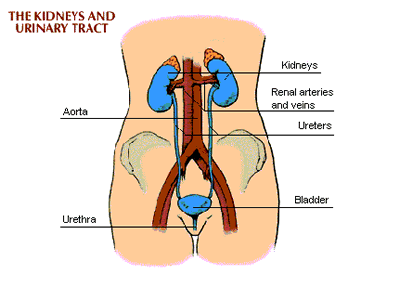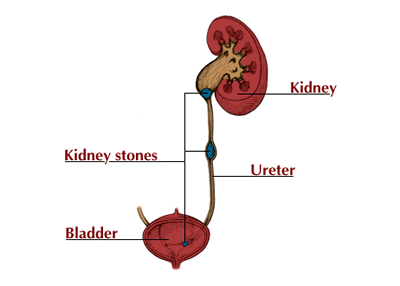Kidney stones
Kidney stones
Kidney stones can cause severe pain and a range of other symptoms. Small kidney stones can cause pain as they pass through the urinary tract. Large stones can become stuck in the kidney, ureter or bladder causing pain and blockage of urine flow. This can lead to infection and kidney damage.
Kidney stones occur more commonly in men than in women. And, while they can occur at any age, kidney stones are more likely to occur in people over 30 years of age.
Kidneys and kidney stones

The kidneys are bean-shaped, fist-sized organs located under the ribs, in the middle of the back. The kidneys filter waste materials and excess fluid from the blood and also produce hormones that are important for blood formation, blood pressure, and bone formation. The kidneys are part of the urinary system which includes; the bladder, ureters (tubes from the kidney to the bladder) and urethra (tube from the bladder to the outside of the body).
Kidney stones (also called renal calculi, renal lithiasis and nephrolithiasis) occur when substances within the urine precipitate and form solid material. Kidney stones can vary in size from a grain of sand to bigger than a golf ball. They can be smooth or they can have jagged edges. There may be a single stone or many stones. There are several types of kidney stones, classified by the substances that form them. The different types include:
Calcium stonesThese are the most common type of kidney stone. They are composed of calcium in combination with either phosphate or oxalate. These occur when there are excess levels of calcium circulating in the blood.
Uric acid stonesThese kidney stones occur when excess amounts of uric acid are present in the blood and tend to occur in people who don't drink sufficient fluids or lose a lot of fluid, and in people who eat a high protein diet. Many people with this type of kidney stone also develop gout – a painful form of arthritis caused by solid deposits of uric acid in the joints.
Struvite stones
These kidney stones are often composed of magnesium ammonium phosphate and tend to occur in people who have repeated urinary tract infections.
These kidney stones are often composed of magnesium ammonium phosphate and tend to occur in people who have repeated urinary tract infections.
Cystine stones
Cystine is a type of amino acid. People with cystine stones usually have an abnormality with the way their body processes amino acids in the diet.
Cystine is a type of amino acid. People with cystine stones usually have an abnormality with the way their body processes amino acids in the diet.

What causes kidney stones
The build-up of the substances that form kidney stones may be as a result of a number of risk factors including urinary tract infections, dehydration, certain medical conditions and metabolic imbalances. However, in the majority of cases the cause is unknown. Factors that can increase the risk of developing kidney stones include:
- Family history of kidney stones
- Poor fluid intake or dehydration
- Structural problems that cause pooling of urine and infection in the kidney
- Having had previous kidney stones
- Some medications taken for other conditions, such as diuretics and corticosteroids.
Medical conditions and metabolic problems that can cause the development of kidney stones include:
- Hypercalciuria – where there are excess levels of calcium in the blood leading to the development of calcium stones. This may be due to medical conditions such as hyperthyroidism and sarcoidosis, or as the result of a diet high in meat, fish and poultry
- Urinary tract infections - these can increase the pH level of the urine causing it to become more alkaline. This is a common cause of struvite stones
- Hyperuricosuria - a problem with uric acid metabolism, leading to the development of uric acid stones
- Cystinuria - a rare disorder leading to the excess production of cystine, leading to the development of cystine stones
- Hyperoxaluria - where there are excess levels of oxalate in the blood
- Excess vitamin D intake.
Signs and symptoms
The most common symptom of kidney stones is intense pain in the loin – the area of the back between the bottom of the ribs and the hip bone. The pain may be felt in the abdomen or lower back and can radiate down to the groin region. The pain is referred to as renal colic and may last for a brief time or for several hours before subsiding. Renal colic is caused by the ureter trying to expel the stone towards the bladder though a wave-like motion (peristalsis). Other symptoms that may be experienced include:
- Nausea and vomiting
- Blood in the urine - as the result of damage to the lining of the ureter or the presence of infection
- Fever or chills
- Repeated urinary infections.
Diagnosis
If kidney stones are suspected, it is important that a doctor is consulted promptly for diagnosis and treatment. Often a diagnosis of kidney stones can be made based on the presenting symptoms and the presence of blood in the urine. An ultrasound scan and/or an abdominal X-ray are usually performed to confirm the diagnosis. Once a diagnosis of kidney stones has been made, referral to a specialist urologist for further assessment may be recommended. Occasionally the specialist may request that a CT scan or a special x-ray using contrast dye (an intravenous urogram) be performed to accurately identify the size and location of the kidney stones.
Treatment
Treatment for kidney stones varies, depending on the type of stone and the cause. Initial treatment aims to relieve pain. This may include giving anti-inflammatory medications (such as diclofenac or ibuprofen) and/or strong narcotic-based pain relief (such as morphine). If pain and other symptoms are severe, admission to hospital may be necessary so that pain relief and fluids can be given via a drip into a vein (intravenously). If infection is suspected or shown to be present, antibiotic medications may be given. Underlying medical conditions that have led to the development of the kidney stones will need to be identified and treated in order to prevent recurrence of the kidney stones.
In the majority of cases the kidney stones will pass by themselves. In these cases the only treatment required is adequate pain relief and plenty of fluids and rest. Medications may be given to relax the muscles in the ureter, helping the kidney stone to pass more quickly and with less pain. In the case of uric acid stones, medications may be given to help dissolve the stones. In cases where the stones are too large to pass, the pain is excessive, or there is evidence of kidney damage or infection, further treatment to remove the stones may be necessary.
Stones are generally removed in two main ways – surgery or lithotripsy. The method used to remove the kidney stones will depend on a variety of factors such as age, medical history and condition of the person, and size, type and location of the stones.
Surgery
The different surgical techniques used to remove kidney stones include:
- Ureteric stone removal – Where a tube is passed via the urethra and bladder into the ureter, where the kidney stones are located and removed
- Percutaneous nephrolithotomy (PCNL) – Where a thin tube with a camera at its tip (a nephroscope) is inserted directly into the kidney through the skin. The stone is located and removed via the tube or shattered by ultrasonic waves
- Open surgery – This may be necessary if the stones are large, are lodged in the kidney, and other techniques to remove the stones are unsuitable.
Lithotripsy (extracorporeal shock wave lithotripsy – ESWL)
Lithotripsy is a non-invasive alternative to surgery and is usually used to treat kidney stones less than 2 centimetres in diameter. It uses high-energy shock waves to shatter the stones. Once the stones are disintegrated, the sand-like fragments that remain pass out of the body in the urine. Large stones may require more than one lithotripsy treatment. For more about this treatment link to our Lithotripsy for Kidney Stones page.
Prevention
Once a person has had a kidney stone, there is an increased likelihood they'll have more. Steps that can be taken to prevent the development or recurrence of kidney stones include:
- Drinking plenty of fluid - 2 litres per day is generally recommended
- Adequately treating underlying medical conditions
- Avoiding food with a high oxalate or salt content
- Eating meat in moderation
Unless advised otherwise by a doctor, people affected by kidney stones should continue to eat calcium rich foods as diets low in calcium can increase the risk of kidney stones in some people. They should also check with a doctor before using calcium supplements as these have been linked with an increased risk of kidney stones.
In some cases medications may be used to help prevent kidney stones reforming by controlling the amount of minerals and acid in the urine. The type of medication prescribed will depend on the kind of kidney stone the person has previously experienced, eg: thiazide diuretics for calcium stones and allopurinol for uric acid stones.
A referral to a dietitian may be recommended to manage dietary changes.
